Disclaimer: This post contains affiliate links to handpicked partners, including tours, gear and booking sites. If you click through or buy something via one of them, I may receive a small commission. This is at no extra cost to you and allows this site to keep running.
Looking for day trips from Venice or Verona or wanting to visit the lesser-known destinations dotted in between? Here’s a pick of the most beautiful places to visit in Veneto, Italy.
When it comes to the Veneto region of Italy, the monumental capital of Venice and the Shakespearean-inspired Verona steal the attention. And while these focal Veneto cities are meritorious, they cradle (and somewhat overshadow) a region worthy of broader exploration.
There are UNESCO landmarks on Lake Garda, Venetian splendour valley villages with mountainous backdrops, some of the best-preserved medieval fortresses in Italy, to hilltop hamlets immortalised by the works of poets, writers, and artists over the centuries. A collection of time capsules and ancient historical trails scattered across northern Italy.
Such beauty and the preservation of it is officially listed. The Borghi Più Belli d’Italia (Most Beautiful Villages in Italy) distinction is a compiled list of villages and historic centres of small towns to preserve and promote some of Italy’s historical landmarks and the foundations of its urban fabric.
Ready to dig deeper? Use this Veneto guide and travel through some of the best historically preserved and visually stunning destinations on a journey through 10 of the region’s most revered small towns and villages.
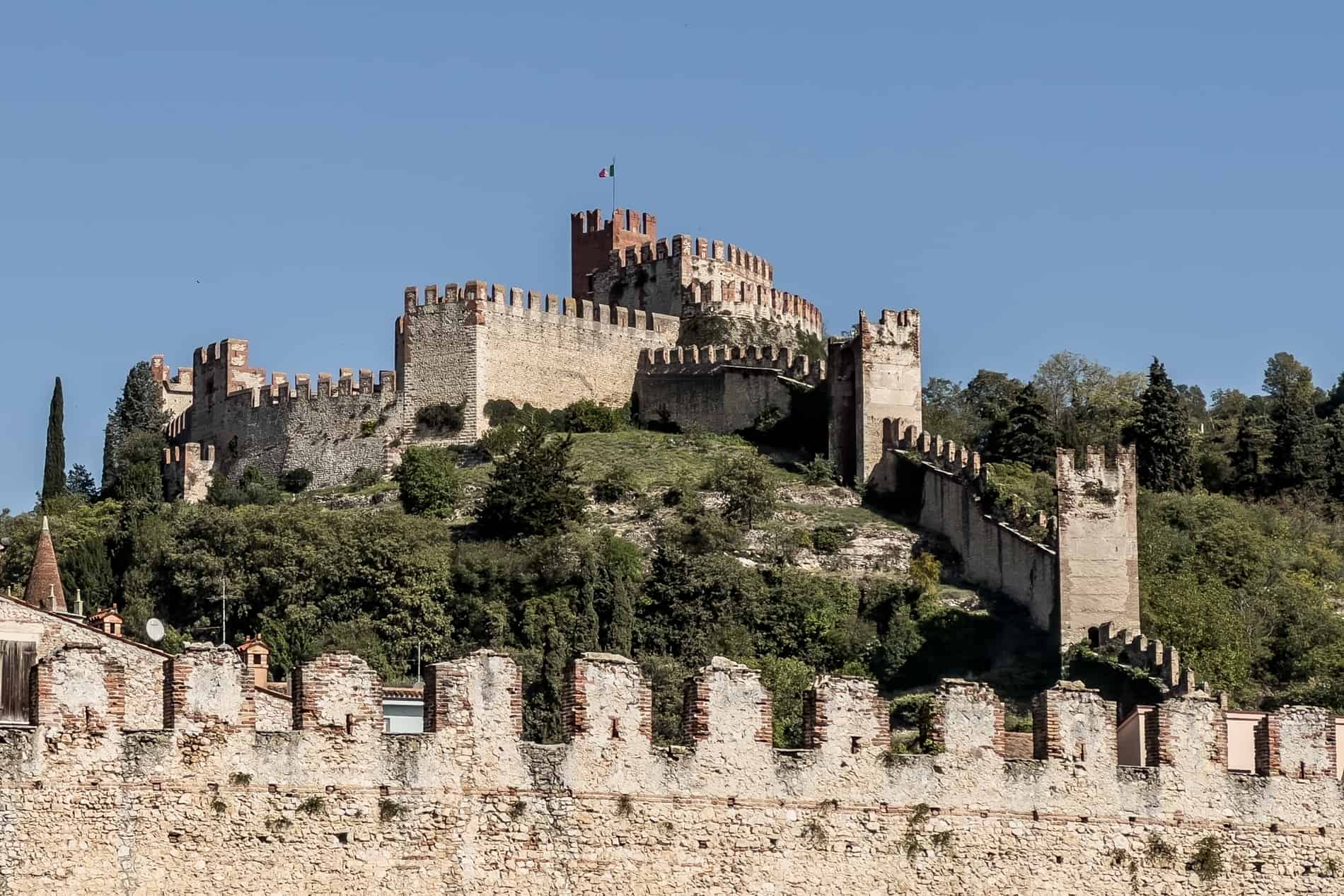
Looking for the most beautiful places to Visit in Veneto, Italy? This guide has you covered.
Contents
Things to Know Before You Visit Veneto
These tips cover everything from planning your trip to getting around the Veneto region.
Where is Veneto in Italy?
Veneto is a north-eastern region of Italy that starts in the Venetian Prealps and expands to stretch between the Dolomites to the Adriatic Sea, where you’ll find Venice, the capital of Veneto. The regions of Trentino Alto Adige border it to the north, Emilia-Romagna to the south, Friuli-Venezia to the east, and Lombardy to the west – which equally shares Lake Garda.
Getting to Veneto
Even if you set out to explore the smaller towns and villages, you will likely start in the major cities of Veneto, especially Venice or Verona. Both have international airports (Venice Marco Polo Airport and Verona Villafranca Airport) and main railway stations (Venice Santa Lucia and Verona Porta Nuova) hubs for onward travel.
I travelled to Veneto via Austria, crossing the border from Tirol and taking the train from Innsbruck. I previously travelled from Austria to Italy to explore another Northern region – Emilia Romagna.
READ MORE: How to See Venice in One Day

You’ll likely start in Venice, the capital of the Veneto region.
Veneto has seven provinces, of which the principal cities outside Verona and Venice – Padua, Rovigo, Vicenza, Treviso and Belluno – attract travellers or serve as further transit points to smaller villages and hamlets.
Getting around Veneto
Veneto by train: The Trenitalia train service connects the cities of Veneto. Digital tickets with a QR code can be scanned upon request on the train. If buying a ticket at the station, stamp it before boarding to validate it.
Book Veneto train tickets here.
Veneto by bus: If travelling to smaller towns, you may have to use a connecting bus service. I used two regional bus networks – ATV (Azienda Trasporti Verona) and MOM (Mobilità di Marca). Both have handy apps for purchasing digital tickets, which you activate once you are on the bus.
Get the Ticket Bus Verona ATV App
Best time to visit Veneto
Visit Veneto between May and September. June to August are the hottest months to visit, reaching close to 30°C but with the highest precipitation. May and September shoulder months see cooler temperatures, perfect for outdoor adventures. Across the region, September is the optimal month to be in Veneto, with temperatures in the comfortable low 20s and the lowest rainfall.
How long to spend in Veneto
I spent 10 days covering 10 villages and small towns on a journey from Verona to Venice. Not all villages require a full day or an overnight stay to see their main attractions (unless you are there for an event).
If you are looking to cover ground and spend time in the Veneto cities on top, then 14 days would be the ideal timeframe to dig deeper into the region.
Alternatively, many of the places to visit in Veneto are listed here as accessible as day trips from Verona or Venice, and you can pick and choose one or two villages to add to your city break.

Factor in plenty of time in Veneto to explore the nature surrounding the villages and small towns.
Places to Visit in Veneto From Verona
These historic hamlets are within easy reach via public transport and less than one hour from Verona.
Peschiera del Garda

Pretty Peschiera del Garda and its colourful old town structures.
Lake Garda’s turquoise basin is steeped in history, and the amber-toned fortified town of Peschiera del Garda on the southern shores is one of the most alluring. Three manmade fortified islands form a trestle between the lake and the Mincio River that funnels from it.
Inside the pentagonal fortress walls of the largest is Peschiera’s colourful and buzzing old town. Cobblestoned streets, buildings coated in ochre and earthy shades, Venetian villas, and Hapsburg-era military stations – old abodes whose ground floors turned into traditional restaurants, cocktail and craft beer bars, and fashion stores.
Walk the history trail, starting from Peschiera’s beginning as the Roman town of Arilica. Take the Via Roma to Piazza Ferdinando di Savoia, and you’ll reach the tiny Abitato Romano di Arilica site – the excavations of Roman homes and courtyards uncovered in 1974. Peschiera grew during the 13th century under the rule of the medieval Scaligeri family. Still, the grand architectural enclosure you see today is the preserved defence systems of the Venetian Republic from the 15th century, declared a UNESCO World Heritage Site in 2017.

The UNESCO Walls of Peschiera del Garda – the timestamp of the Venetian Republic.
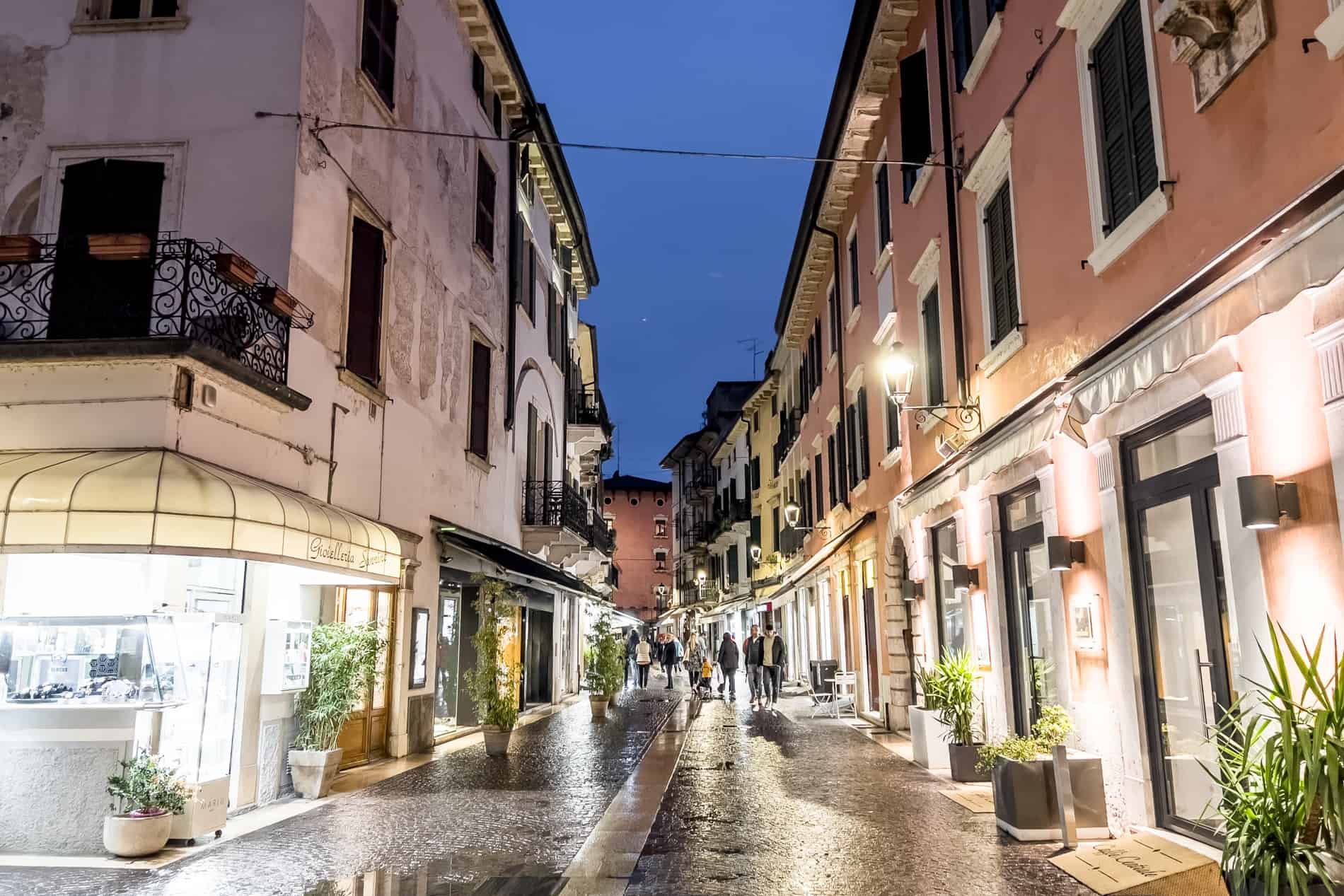
Peschiera del Garda at night, filled with bars, restaurants and gelaterias.

The unearthed Roman ruins in Peschiera del Garda.
Book: A day trip with Bike Experience, combining history with a bike tour to the hamlet of Borghetto sul Mincio.
How to get to Peschiera del Garda: Take a train from Verona to Peschiera del Garda – a 15-minute train ride on the local Trenord service.
Where to stay: I stayed at II Giardino Segreto – a modern room in a local property. It’s a 10-minute walk from the train station, a 5-minute walk to the historic centre, and 2 minutes to the shores of Lake Garda.
Borghetto Sul Mincio

The quaint beauty of Borghetto Sul Mincio.
The quaint hamlet of Borghetto is a beauty in isolation, clustered on the opposite bank of the Mincio River, the town of Valeggio sul Mincio and the 600,000 square metres Sigurtà Garden Park. It brims with visitors, just as it always has, Borghetto being once the path of merchants and a sanctuary on the pilgrimage points through Santiago de Compostela, Rome, and Jerusalem.
Remnants of medieval gates and bridges and the traces of cobblestoned lanes past ancient working water mills are what remains of this once-powerful fortification that formed part of a complex of villages connected by walls. The vestiges of the Visconteo Bridge, a once 650-metre-long, 25-metre-wide pass built in 1393 to defend the late medieval city from Venetian influence, lead to the hilltop fortress of Scaligero Castle and the 14th-century towers that still protectively look out over the villages, as you can too.
Borghetto is the setting for the “Legend of the Love Knot” – the tied golden handkerchief left by the River Mincio by a nymph as a token of her love for a soldier. Fable to feast, it is the perfect excuse to eat the traditional Tortellini di Valeggio – a smaller version of the famous pasta that resembles the love knot. Giardini di Borghetto is the place to try it.

Visitors wandering through the medieval remnants of Borghetto Sul Mincio.

The old stone tower in Borghetto, on the River Mincio.
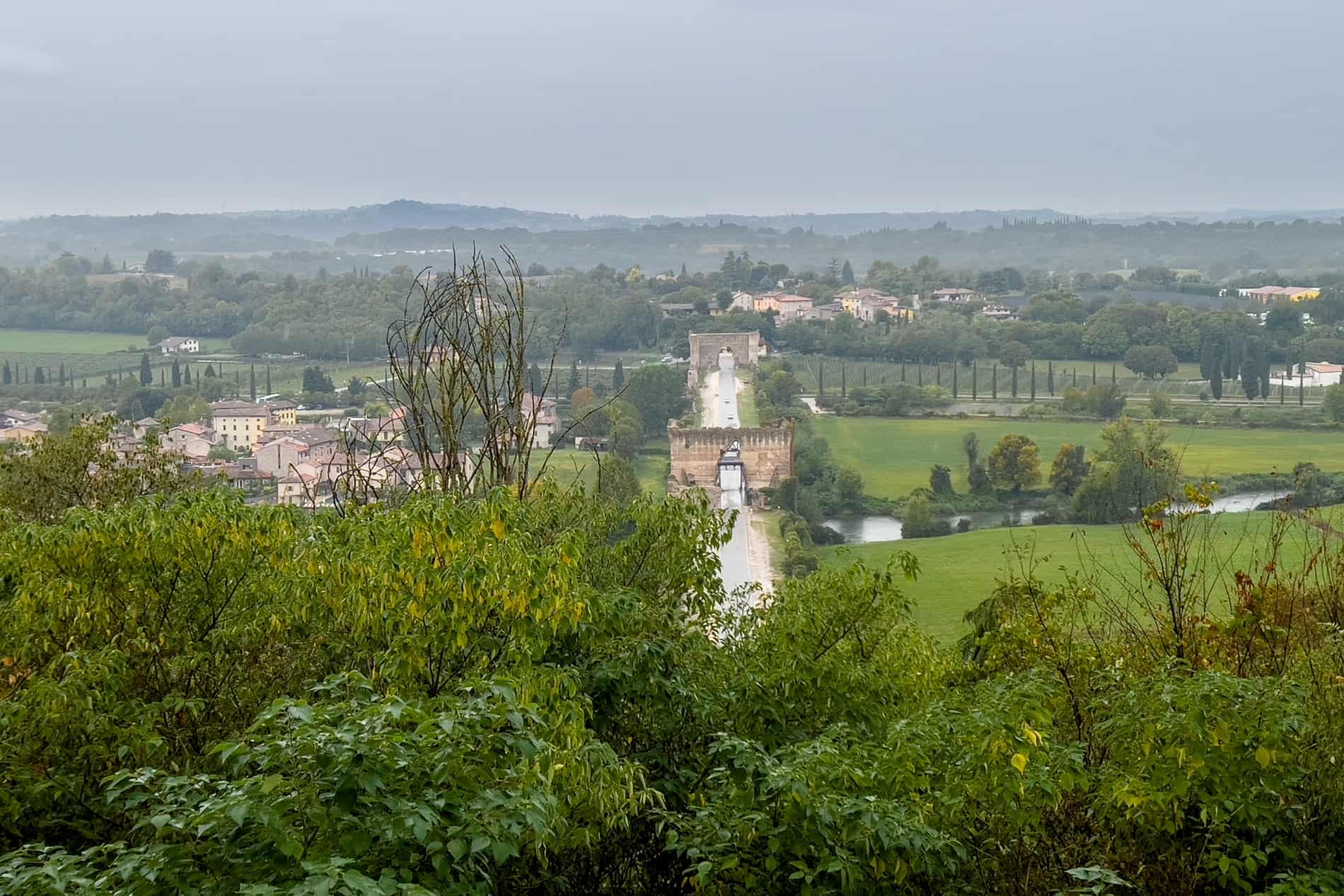
The view from the hilltop castle over the Borghetto’s Visconteo Bridge structure.
How to get to Borghetto: Take the 12km, 45-minute bike ride to Borghetto Sul Mincio from Peschiera del Garda following the route ‘Ciclovia del Fiume Mincio’ that connects to Mantova on an overall 45km path. Walking to Borghetto along the course of the Mincio River would take around 2 hours and 30 minutes.
Where to stay: Day trips to Borghetto from Peschiera del Garda are typical. If you want to stay overnight, there are mid-range price options in neighbouring Valeggio Sul Mincio, including the family-run B&B Ombretta that’s 500 m from Borghetto.
Soave

Italy’s most beautiful village, Soave
It’s no wonder Soave won Italy’s most beautiful village distinction for 2022 – it’s known for being one of the best-preserved medieval villages in the country. The ground walls, towers and gates, and the old fortress complex rising from the hill are almost entirely intact, encasing a beautiful historic centre.
Soave’s Roman groundwork was fortified in the 13th century by ruling families of the Middle Ages before the Venetian Republic nobility moved in, leaving behind a road lined with a noble stature. Pass Palazzo Scaligero Delo Capitano, Palazzo Moscardo, Palazzo Di Giustizia, and Palazzo Cavalli on the walk between the grand gates of Porta Aquila and Porta Verona.
Soave, hugged by vineyards, is noted for its wine culture. If you are not joining those on the street sipping on the Soave Classico made from the regional white Garganega grape in one of the bars, then a cellar tour and tasting are a must. Find Cantina Coffele and Cantina Del Castello within the village and the famed Rocca Sveva next to the ancient castle walls.
Combine history and wine on the Monte Tenda nature trail – a two-hour circular trek that curves through a panorama of vineyards before winding up to the medieval and Venetian meld of courts, towers, and turrets of the ancient citadel on the Tenda hill.

The entrance to Soave via the mighty Porta Aquila.

The palazzos and fortress views of Soave.

The vineyard views walking the Monte Tenda trail.
How to get to Soave: The ATV bus line 130 from Verona gets you there in 45 minutes.
Where to stay: I stayed in the quaint, book-themed B&B Antique Maison, around a 5-minute walk from the centre of Soave. Privately owned with a homestay village feel.
Places to Go in Veneto between Verona and Venice
Head into the centre of Veneto and find two of the region’s revered medieval fortified towns.
Montagnana
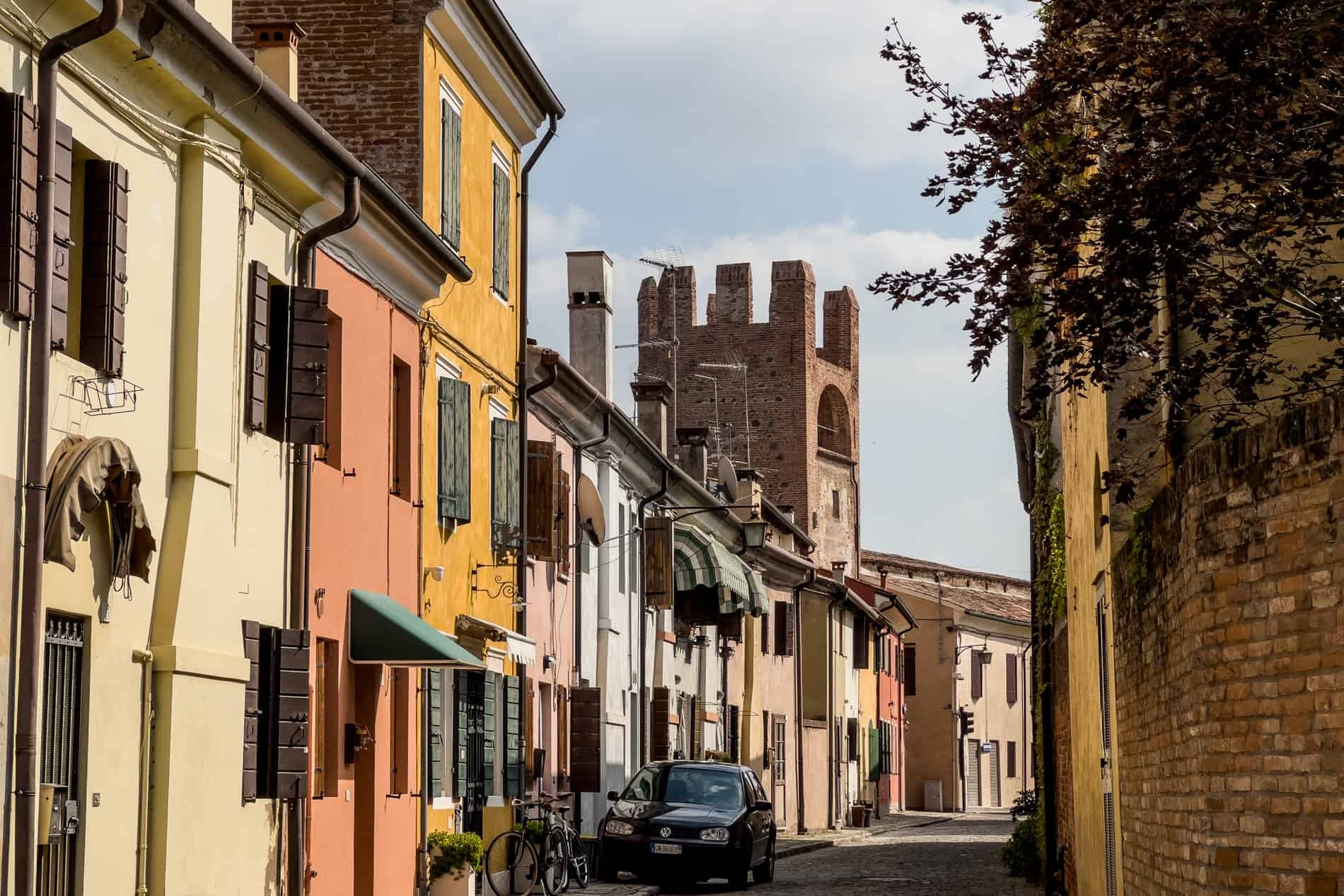
The meld of old walls and colourful houses in Montagnana.
As soon as you arrive in Montagnana, you can see why it is defined by its preserved medieval citadel – a village surrounded by 2 kilometres of majestic old walls, 24 towers and four gates up to 8 metres high. Porta Legnago has a prime view of the long stretch of wall, with the oldest gate of Porta Padova sheltering the San Zeno Castle. Now the archaeological exhibit-filled Civic Museum, it’s also where you can access the tower for elevated views over the vast fortress.
Being in Montagnana is to move from the history of medieval defence as you pass through the walls to the splendour that filled the village during the Venetian era. The bronze-hued walls enclose a historical centre full of houses in colourful rows and streets that lead to the Piazza Comunale square lined with palatial elegant, arcaded Venetian villas. The Cathedral of Santa Maria Assunta, from 1502, stands out with its combined gothic and renaissance features and looks directly at the landmark Palazzo Valderi.
Montagnana also prides itself on its Prosciutto, with the Veneto Berico-Euganeo DOP (Protected Designation of Origin) stamp of quality. It’s found on almost every menu, served on aperitivo plates, and showcased in Prosciuttificios like Attilio Fontana outside the city walls.

The old walls of Montagnana, Veneto.

Montagnana’s structures through the ages.

The Cathedral of Santa Maria Assunta – Montagnana’s masterpiece.
How to get to Montagnana: Take the train from Venice or Verona to Montagnana – 1 hour and 35 minutes to 2 hours total journey time.
Where to stay: I stayed overnight in Sotto le Mura on the corner of Porta Padova. No thrills apartments but with incredible views to the walls.
Marostica

The Lower Castle of Marostica.
You can’t tell that Marostica was once a Roman military outpost. The village’s location right in the centre of Veneto saw its fortifications enlarged by the Scaligeri family, who ruled Verona and the Veneto region during most of the 14th century. It’s known today for these preserved fortress ruins constructed in 1312, with curving hilltop walls.
On a one-hour walled village hike, start at Porta Bassano, and follow the route of the walls that snake their way on the hill. Take the forested, rocky trail path to the Upper Castle for a view directly to the strategically placed Lower Castle bastion.
Reliving the traditions of the Venetian Republic, the La Partita a Scacchi di Marostica live human chess game in Marostica’s masterpiece, played on the giant chessboard in front of the Lower Castle. It follows the story of noblemen Rinaldo d’Angarano and Vieri da Vallonara, who fight for the hand of the Lord of Marostica’s beautiful daughter, Lionora. Outside of the event, which takes place every second weekend of September on even-numbered years, the Lower Castle (Castello Inferiore) is a museum primarily dedicated to the game, showcasing props and costumes.

Marostica is known for its giant chessboard, which hosts the La Partita a Scacchi di Marostica live human chess game.
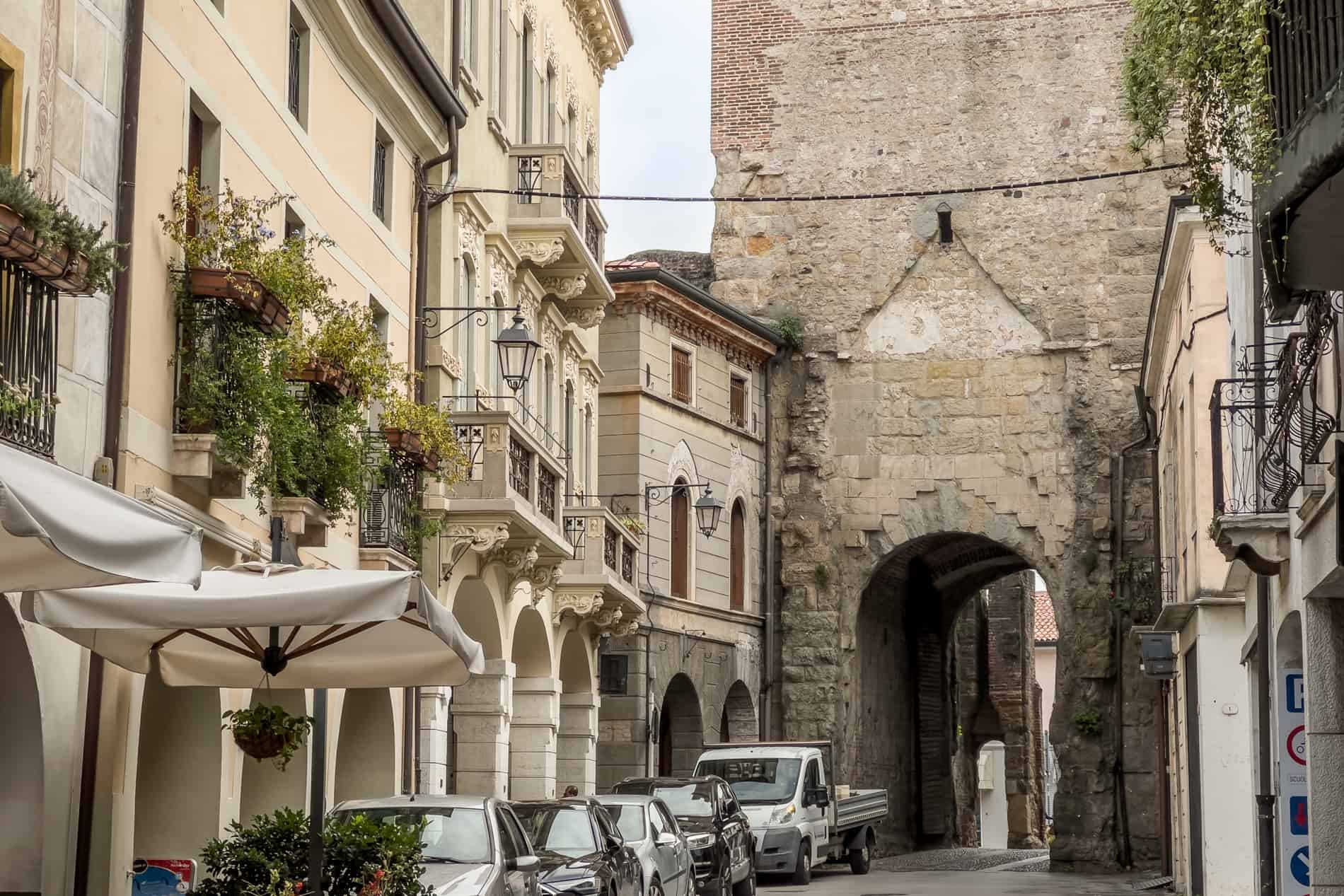
Porta Bassano is a great starting point when you visit Marostica.

Clamber the pathways to Marostica’s Upper Castle ruins.
How to get to Marostica: Take the train from Verona to Vicenza and then Bus 1005 (direction of Bassano del grappa) – a total journey time of 2 hours and 30 minutes. Take a train from Venice to Bassano Del Grappa and change for Bus 1005 (direction of Vicenza) – a total journey time of 1 hour and 40 minutes.
Where to stay: You can see Marostica comfortably in half a day, but if you want to stay overnight, then B&B Borgo Castello is lovely. Rooms have wood-panelled ceilings mixed with classic-modern décor, with views to the hilltop castle.
Places to Visit in Veneto From Venice
Venice is enticing, but go find the pockets of Venetian elegance and medieval magnificence in towns nearby and take the chance to get closer to the mountains.
Arquà Petrarca

The poetically inspired Arquà Petrarca village.
This hilltop village set to a backdrop of unfurling green slopes and mountain trails was immortalised by the 14th-century Italian poet Francesco Petrarca who described it as “rich of green vegetation and full of peace”. Once you arrive, you will no doubt agree.
Arquà Petrarca is a model village of beauty. Old medieval dwellings like the 12th-century Loggia del Vicari where the medieval ruling families would meet, silver stone houses, picture-perfect whitewashed cottages, and grand Venetian villas jostle for space on the layering of winding roads and stone staircases. No wonder Petrarca spent the last years of his life here from 1370 to 1374. You can visit his tomb in the heart of the charming cobblestoned medieval hamlet at Palazzo Contarini, next to the fresco-filled Parish Church of Santa Maria Assunta.
The streets are filled with al fresco diners on Piazza San Marco and people enjoying a glass of wine on Strada Provinciale avenue of vino bars and stores. It brings locals together with the hikers and bikers who pass through as they journey through the villa-set hills and mountainous trails.
The Atestino trail is the closest hike path to the village, a 20-km five-hour circular route through the peak plains and passes of Mount Rusta and the Marlunghe ridge that ends at Petrarch’s home close to the entrance of the village. Whatever path you take here, his legend and poetic words live on.

Overlooking the lower half of Arquà Petrarca.

Get lost in Arquà Petrarca’s set-stone streets.

The hilltop hamlet is Arquà Petrarca is one of Italy’s most beautiful villages.
How to get to Arquà Petrarca: Take the train from Venice to Monselica, the closest station to Arquà Petrarca, which is approximately 5 minutes away by taxi. A total journey time of around 90 minutes.
Where to stay: I stayed in the beautiful garden-set Borgo Petrarca, in the middle of the village, with a prime view over the lower hamlet and a two-minute walk to the Piazza San Marco.
Asolo

Asolo street life.
Asolo, the “Town of a Hundred Horizons”, so called for its romantic setting on the rolling hills between the Venetian plains and the eastern Alps. Inhabited since prehistoric times, it became an important Roman Municipium and was ruled by the four families of Ezzelini, Scaligeri, Carraresi, and Trevigiani during the Middle ages. Under the Venetian Republic, it became illustrious, attracting poets, painters, writers, and thinkers.
Today it melds together these historical elements. Medieval relics and romantic streets whose arcades house the workshops of painters, sculptures, and fashion designers. Winding lanes with old stone houses and pretty palazzos like the 15th-century Palazzo della Ragione turned village museum and art treasury. The residents of artists who called Asolo home, the most well-known being Villa Freya, the abode of English writer and traveller Freya Stark, who retired in Asolo in the 1970s. It’s also a popular attraction for the remains of the foundations of a roman theatre in the house’s garden.
A symbol of the village, climb the Rocca monument perched atop Monte Ricco at 310m, dating from the late 12th to the early 13th century. Take it all in from great heights with views to the Dolomites, then look up to it from the lower Castello della Regina Cornaro, where the 15th-century Venetian Queen Carnaro, the last monarch of the Kingdom of Cyprus, lived in exile.
Asolo’s award-winning prosecco, which has a DOCG (designation of origin and guaranteed) distinction in the Veneto wine region, adds an extra layer of elegance. End the day sampling the sweetness and carbonation varieties of these prized bubbles with a tasting in the Asolo Wine Shop.
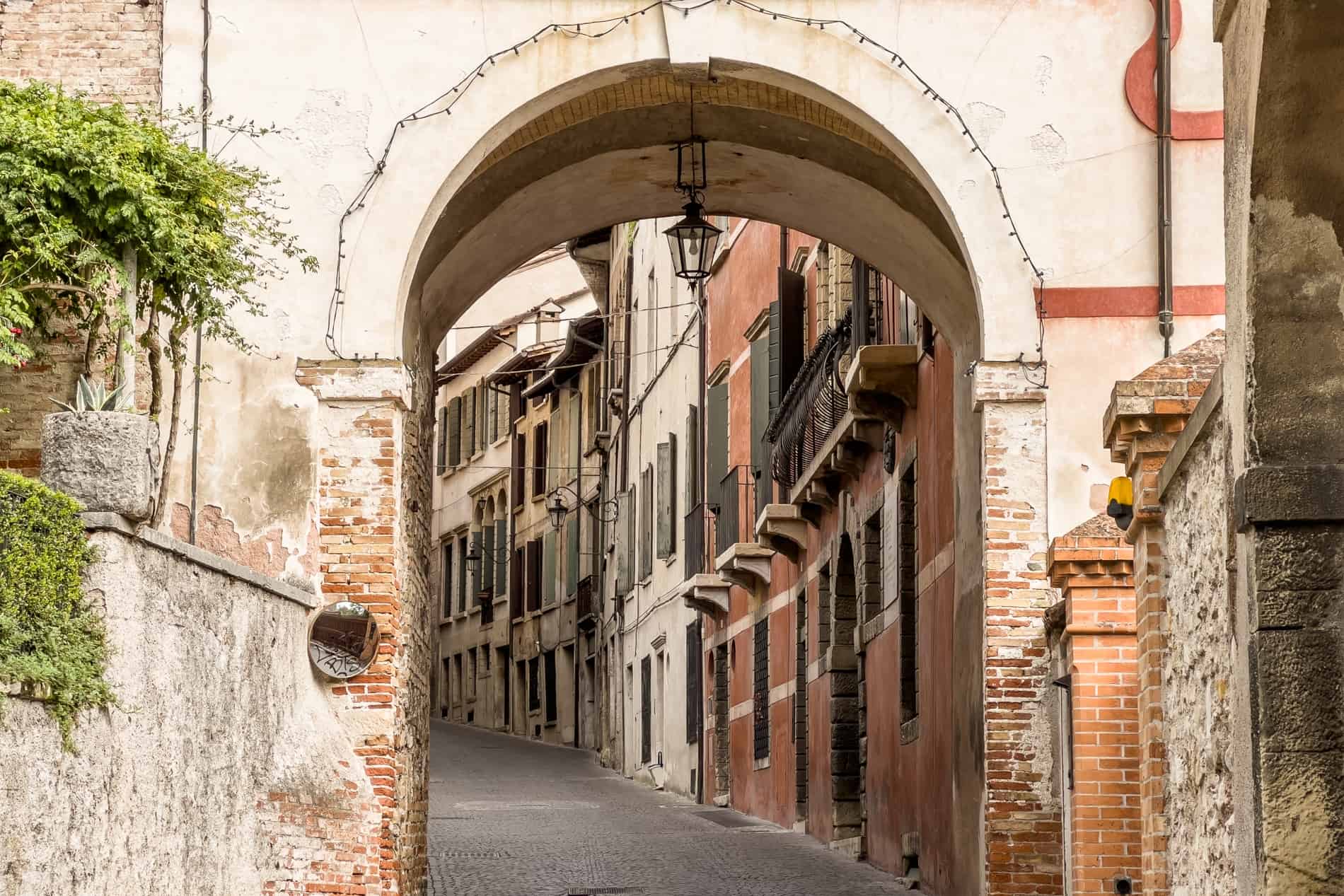
Wander the beautiful earthy-toned streets of Asolo.

The romance of Asolo.

Asolo, the “Town of a Hundred Horizons” with the hilltop Rocca monument.
How to get to Asolo: Take the 40-minute train from Venice to Treviso. From there, take bus 112 towards Bassano del Grappa, which reaches Asolo after approximately 1 hour.
Where to stay: Close to the heart of Asolo is the apartment hotel Il Molino – a restored 16th-century villa with preserved frescos, sleek modern design and incredible mountain views.
Mel (Borgo Valbelluna)

The Dolomites-backed village of Mel.
The dramatic backdrop heightens Mel’s pocket of Venetian grandeur – this small village in the centre of the Valbelluna (Belluno Valley) sits in front of the towering Dolomites.
An architectural cocktail of the ages, Mel’s history spans from the ancient Paleo-Venetian times in the first millennium BC to the arrival of the Romans, the feudal Middle Ages, and the nobility of the Venetian Republic, and the Zorzi family who ruled for three centuries.
See it in the stone circles of the Necropolis site close to the centre, the hilltop Castle of Zumelle and the historical centre that preserves the old noble Venetian town. Piazza Papa Luciani square keeps its timeless villas and elegant palazzos like the landmark 16th century Palazzo Cappello and Zorzo Palace turned city hall. Artefacts from all ages are gathered in the Civic Archaeological Museum in the Palazzo delle Contesse.
Trip through the valley on the ‘Anello del Borgo’ trail. Follow the blue signs and walk a 6.7 km loop through the verdant plain on the Piave river, walking in parallel to the mountainous walls before circling back to the village, where the soft hills of the Venetian Prealps hug it from the other side.

Piazza Papa Luciani square and its landmark palazzos.

Mountain views on the ‘Anello del Borgo’ trail.

The cosy cafe corners in the historic heart of Mel.
How to get to Mel: Take the 3-hour 30-minute train from Venice to Belluno, where you can pick up the 25-minute bus connection to Mel.
Where to stay: I stayed in Palazzo Cappello. This 16th-century Venetian villa is a landmark of the Piazza Papa Luciani, with traditional wood beam ceilings and fresco-painted walls. It also has a prime view over the square.
Cison di Valmarino

Piazza Roma, the centre of Cison di Valmarino village.
What might appear to be a secluded, tranquil hamlet was once a place of great importance. Cison di Valmarino was a centre point in the Middle Ages where the noble families of the 12 villages would meet. Today, this village is a window into that time, mainly of the Brandolini family, who ruled the area of the Valmarino Feud of the Venetian Republic for three centuries. As for the Romans, it’s said the remnants of the village are 1 kilometre away on a hilltop. The Venetian elements dominate.
Piazza Roma oozes importance. A quad of landmark buildings like the 15th-century Palazzo Zambaldi town hall and 17th-century Teatro la Loggia where those meetings took place (now a performing arts venue and vintage radio museum), and Villa CasaBrando, the former family residence a short walk from the Cantine Brandolini winery. Follow the numbered information boards and learn about the set-up of the village, including the agricultural industry in the ancient stables in Case Marian.
Castle Brando is a reminder of defence – the hilltop fortification was the military garrison and residence of the Brandolini, dominating and protecting the village. Today this compact complex is a luxury hotel complex with a restaurant and spa, but you can take the funicular up and admire that view that was once so exclusive and off-limits.
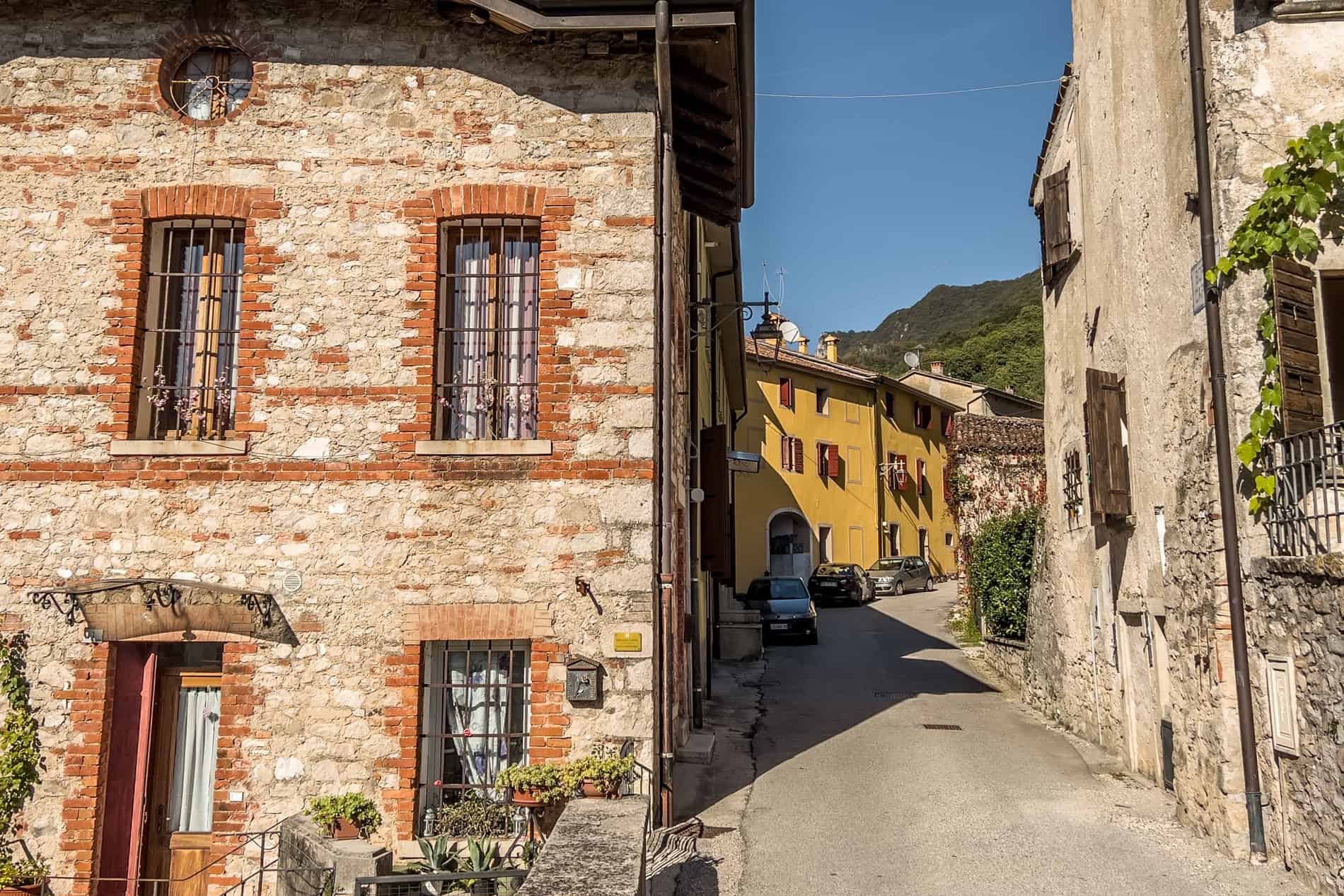
Old laneways and noble stone houses of Cison di Valmarino.

Views to Castle Brando – the former hilltop fortification turned luxury hotel.

Cison di Valmarino – beauty on every corner.
How to get to Cision di Valmarino: Take the 1-hour train from Venice to Susegana, where you can get Bus 117 at Ponte Della Priula, which takes 50 minutes to reach Cision di Valmarino.
Where to stay: I stayed at the family-run Agriturismo La Dolza, an equal distance between Cison di Valmarino and Follina. A beautiful natural setting with horse-riding stables and a restaurant which serves incredible dishes made using products grown and produced on-site.
Borgo di Follina

Finding the colourful painted houses in Borgo di Follina.
A 30-minute walk from Cision di Valmarino, Follina makes for a beautiful village combo. This tiny village is a cluster of little farmhouse-lined lanes, streets of caramel-toned houses and faded mansions built upon the trickling streams.
Its central heart is a row of villas painted in earthy pinks and yellows, with decorated facades – the colourful neighbours to Follina’s most revered architectural treasure, the Abbey of Santa Maria.
This village was built upon the foundations of wool production, renowned in the Venetian Republic for its exceptional sulk and wool products. Foundations dating back to 1268 when Cistercian monks moved into the Abbey.
While the industry declined by the 18th century, the village kept some of the old wool mills and cloth factories as heirlooms. The 17th-century Palazzo Barberis Rusca, with its faded mocha façade and elegant dark wooden shutters, is the most well-known.
Follina and Cision di Valmarino sit between two UNESCO World Heritage Site wine-growing areas that cradle the valley – Valdobbiadene and Conegliano. Bikers, hikers, and wine enthusiasts pass through the area on a 45km pathway known as Prosecco and Conegliano Valdobbiadene Hills Wine Route.
Whichever way you choose to visit, be sure to try the renowned extra dry sparkling white wine with the DOCG quality seal, even if you join the locals sitting outside the wine bar or cafe.

Faded beauty of the once prosperous age of Follina.
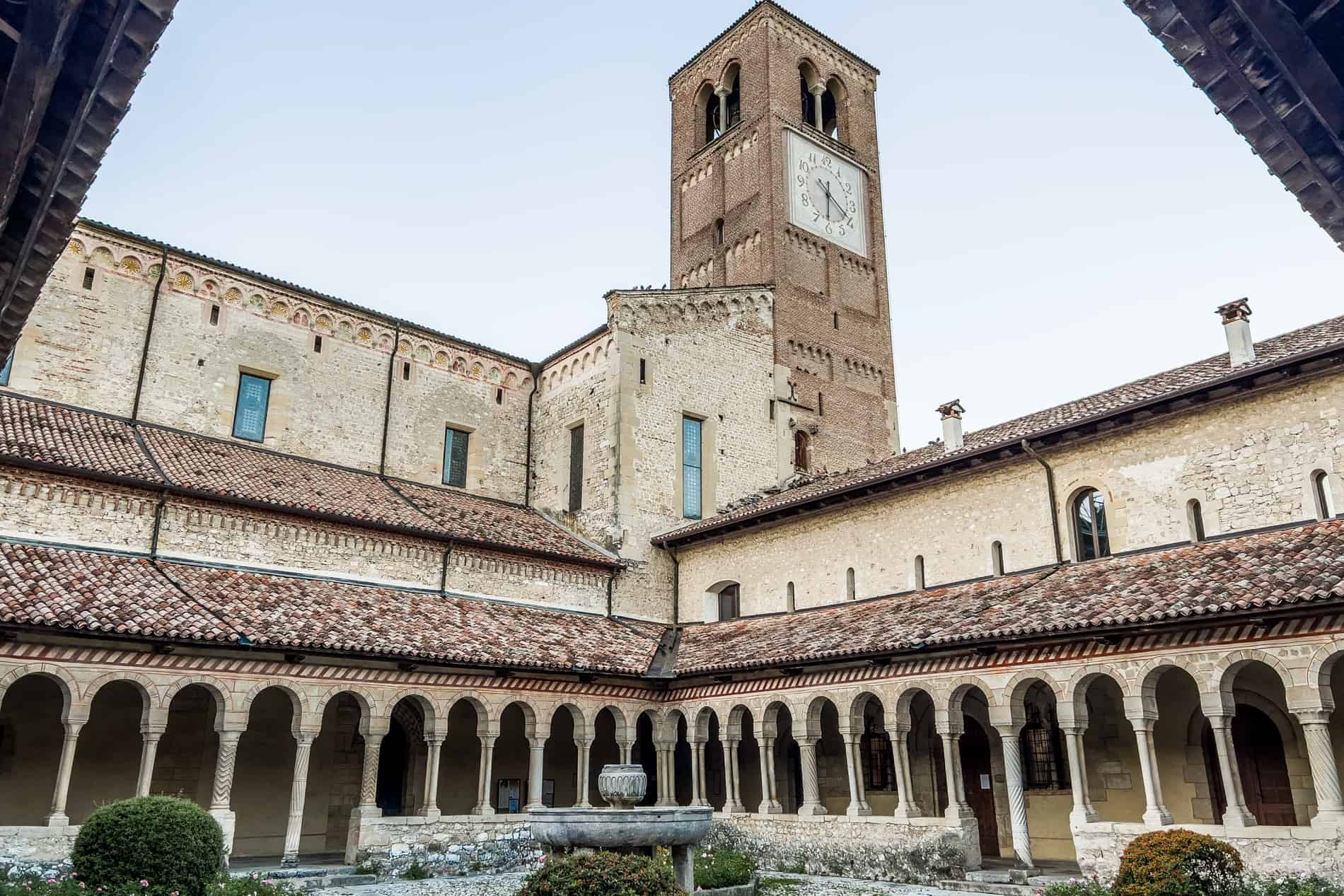
Inside the courtyard of the 13th-century Abbey of Santa Maria in Follina, Veneto, Italy.

The 17th-century Palazzo Barberis Rusca – an old wool mill and a window to the past.
How to get to Follina: Borgo di Follina is a 35-minute walk from Cision di Valmarino.
These 10 villages and small towns only touch the service of what the Veneto region has to offer. What place will you choose to visit first?
See More of Unknown Italy
Ready to see more of the lesser-known destinations across all of Italy’s 21 regions? As part of a country-wide campaign, 20 creators and I toured the country in search of little-known villages (Borghi), beautiful landscapes, unique experiences, and cultural traditions. The ‘Discover Unknown Italy’ ebook gathers all our stories in one place, and what’s more, it’s free!
Where will your next Italian trip be?
This Veneto guide was written in collaboration with iambassador for the ‘Viaggio Italiano Project (Italian National Tourist Board, Ministry of Tourism & Conference of Regions, and Autonomous Provinces). All opinions on the Veneto destinations remain my own.



Leave a Reply